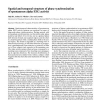Free Online Productivity Tools
i2Speak
i2Symbol
i2OCR
iTex2Img
iWeb2Print
iWeb2Shot
i2Type
iPdf2Split
iPdf2Merge
i2Bopomofo
i2Arabic
i2Style
i2Image
i2PDF
iLatex2Rtf
Sci2ools
BC
2005
2005
Spatial and temporal structure of phase synchronization of spontaneous alpha EEG activity
Spatiotemporal characteristics of spontaneous alpha EEG activity patterns are analyzed in terms of large-scale phase synchronization. During periods with strong phase synchronization over the entire scalp, phase patterns take either of two forms; one is a gradual phase shift between frontal and occipital regions and the other is a stepwise pattern with a sudden phase shift in the central region. The former is regarded as a traveling wave of electrocortical activity, of which the direction of propagation is predominantly from anterior to posterior in three out of four subjects, and opposite in the remaining one. The other activity pattern observed may correspond to a standing wave composed of two traveling waves propagating in opposite directions. The duration distributions of these patterns have similar forms within a subject, which suggests that they share the same mechanism for their generation.
| Added | 15 Dec 2010 |
| Updated | 15 Dec 2010 |
| Type | Journal |
| Year | 2005 |
| Where | BC |
| Authors | Junji Ito, Andrey R. Nikolaev, Cees van Leeuwen |
Comments (0)

